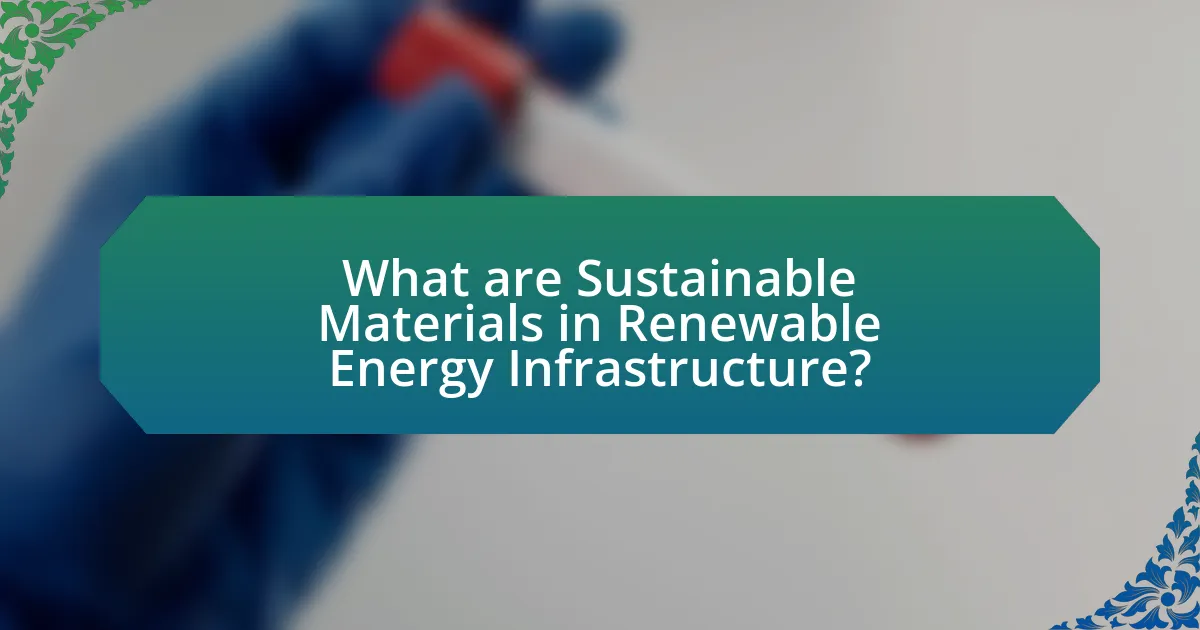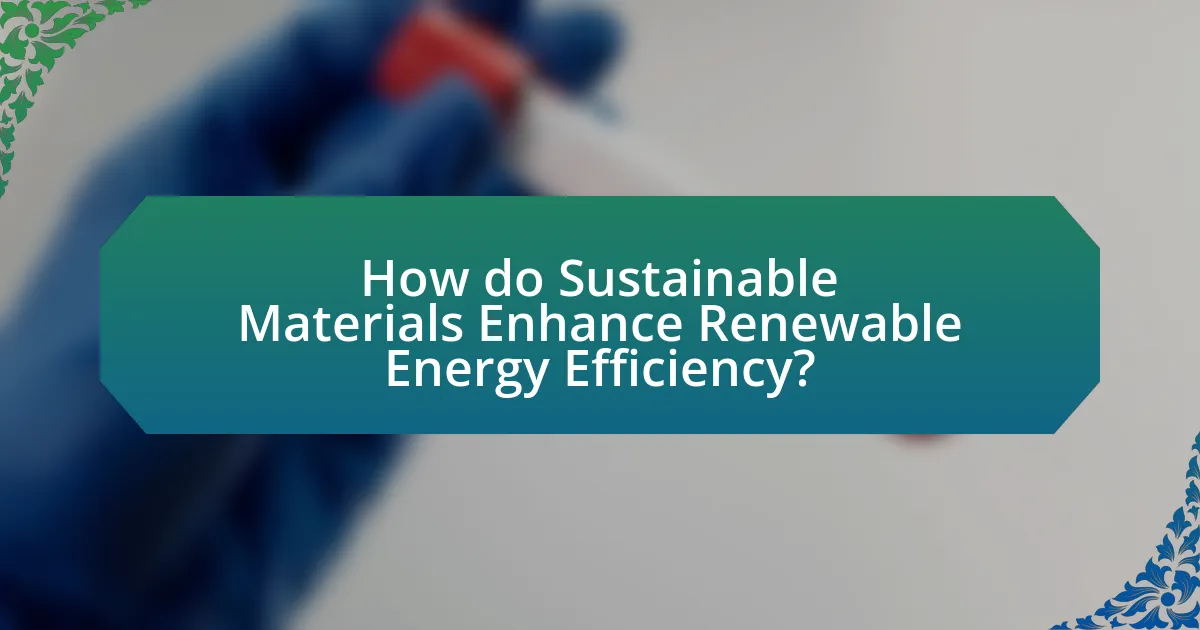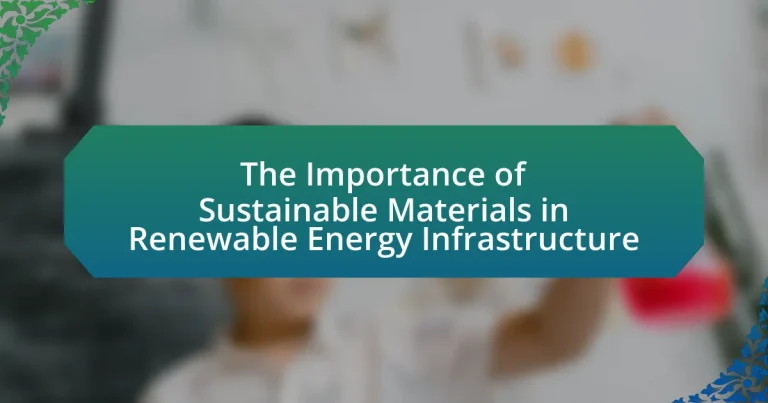Sustainable materials play a crucial role in renewable energy infrastructure by providing environmentally friendly resources that minimize ecological impact throughout their lifecycle. This article explores the definition of sustainable materials, their significance in reducing greenhouse gas emissions, and their contribution to resource efficiency. It discusses various types of sustainable materials, such as recycled metals, bamboo, and bio-based composites, and highlights their advantages over traditional options in terms of performance and cost-effectiveness. Additionally, the article addresses challenges associated with sourcing sustainable materials, the economic implications of their use, and best practices for successful integration into renewable energy projects.

What are Sustainable Materials in Renewable Energy Infrastructure?
Sustainable materials in renewable energy infrastructure are resources that are environmentally friendly, renewable, and have a minimal ecological footprint throughout their lifecycle. These materials include recycled metals, bio-based composites, and sustainably sourced wood, which contribute to reducing greenhouse gas emissions and conserving natural resources. For instance, using recycled aluminum in solar panels can lower energy consumption during production by up to 95% compared to virgin aluminum. Additionally, materials like bamboo and hemp are increasingly utilized due to their rapid growth rates and ability to sequester carbon, further enhancing the sustainability of renewable energy projects.
Why are sustainable materials crucial for renewable energy projects?
Sustainable materials are crucial for renewable energy projects because they minimize environmental impact and enhance resource efficiency. Utilizing materials such as recycled metals, bamboo, and bio-based composites reduces carbon emissions and energy consumption during production. For instance, the use of recycled aluminum in solar panel frames can save up to 95% of the energy required to produce new aluminum. Additionally, sustainable materials often have a lower lifecycle impact, contributing to the overall sustainability of renewable energy systems. This alignment with environmental goals supports the transition to a low-carbon economy and promotes long-term viability of renewable energy initiatives.
What defines a material as sustainable in this context?
A material is defined as sustainable in the context of renewable energy infrastructure if it is sourced, produced, and disposed of in a manner that minimizes environmental impact while maximizing resource efficiency. Sustainable materials often include those that are renewable, recyclable, or biodegradable, and they contribute to reducing carbon emissions throughout their lifecycle. For instance, materials like bamboo and recycled metals are considered sustainable because they require less energy to produce and can be reused or repurposed, thereby decreasing waste and resource depletion.
How do sustainable materials contribute to environmental goals?
Sustainable materials contribute to environmental goals by reducing resource depletion, minimizing waste, and lowering greenhouse gas emissions. For instance, using recycled materials in construction can decrease the demand for virgin resources, thereby conserving natural habitats and reducing energy consumption associated with extraction and processing. According to a study by the Ellen MacArthur Foundation, transitioning to a circular economy, which heavily relies on sustainable materials, could reduce global greenhouse gas emissions by 39% by 2030. This demonstrates that sustainable materials play a crucial role in achieving significant environmental targets.
What types of sustainable materials are commonly used?
Sustainable materials commonly used include bamboo, recycled metals, reclaimed wood, and bioplastics. Bamboo is favored for its rapid growth and renewability, making it an eco-friendly alternative to traditional timber. Recycled metals, such as aluminum and steel, reduce the need for virgin resources and lower energy consumption during production. Reclaimed wood repurposes existing materials, minimizing waste and preserving forests. Bioplastics, derived from renewable biomass sources, offer a biodegradable alternative to conventional plastics, reducing environmental impact. These materials contribute to the sustainability of renewable energy infrastructure by promoting resource efficiency and reducing carbon footprints.
What are the most popular renewable materials in energy infrastructure?
The most popular renewable materials in energy infrastructure include bamboo, recycled steel, and bio-based composites. Bamboo is favored for its rapid growth and strength, making it an excellent choice for construction. Recycled steel is widely used due to its durability and the significant reduction in carbon emissions associated with its production compared to new steel. Bio-based composites, derived from natural fibers and resins, are increasingly utilized for their lightweight properties and lower environmental impact. These materials contribute to sustainable energy infrastructure by minimizing resource depletion and reducing greenhouse gas emissions.
How do these materials compare to traditional options?
Sustainable materials in renewable energy infrastructure generally outperform traditional options in terms of environmental impact and resource efficiency. For instance, materials like bamboo and recycled metals have a lower carbon footprint compared to conventional materials such as concrete and virgin steel, which contribute significantly to greenhouse gas emissions during production. Research indicates that using recycled aluminum can reduce energy consumption by up to 95% compared to producing new aluminum from bauxite ore. Additionally, sustainable materials often enhance the longevity and resilience of infrastructure, leading to lower maintenance costs over time.
What challenges are associated with using sustainable materials?
Using sustainable materials presents several challenges, including higher initial costs, limited availability, and performance issues. Higher initial costs arise because sustainable materials often require advanced technologies or processes for production, which can lead to increased prices compared to conventional materials. Limited availability is a challenge as the supply chain for sustainable materials may not be as developed, making it difficult to source them consistently. Performance issues can also occur, as some sustainable materials may not meet the same durability or efficiency standards as traditional materials, potentially impacting the overall effectiveness of renewable energy infrastructure. These challenges can hinder the widespread adoption of sustainable materials in the renewable energy sector.
What are the economic implications of sourcing sustainable materials?
Sourcing sustainable materials has significant economic implications, primarily by reducing long-term costs and enhancing market competitiveness. Companies that invest in sustainable materials often experience lower operational costs due to decreased energy consumption and waste management expenses. For instance, a study by the Ellen MacArthur Foundation found that transitioning to a circular economy, which includes sustainable sourcing, could generate $4.5 trillion in economic benefits by 2030. Additionally, sourcing sustainable materials can lead to increased consumer demand, as consumers are increasingly prioritizing environmentally friendly products, thus driving sales and market share for businesses that adopt these practices.
How do supply chain issues affect the availability of sustainable materials?
Supply chain issues significantly reduce the availability of sustainable materials by disrupting the flow of resources needed for production. For instance, delays in transportation, shortages of raw materials, and increased costs can hinder manufacturers’ ability to source sustainable inputs like recycled metals or bio-based plastics. According to a report by the World Economic Forum, disruptions in global supply chains can lead to a 20-30% decrease in the availability of critical materials, which directly impacts industries reliant on sustainable practices. This scarcity can result in increased reliance on less sustainable alternatives, undermining efforts to promote renewable energy infrastructure.
How do sustainable materials impact the lifecycle of renewable energy systems?
Sustainable materials significantly enhance the lifecycle of renewable energy systems by reducing environmental impact and improving resource efficiency. These materials, such as recycled metals and bio-based composites, minimize carbon emissions during production and disposal, thereby contributing to a lower overall ecological footprint. For instance, using recycled aluminum in solar panels can reduce energy consumption by up to 95% compared to using virgin aluminum, as reported by the International Aluminum Institute. Additionally, sustainable materials often have longer lifespans and better performance characteristics, which can lead to reduced maintenance costs and increased energy output over time. This integration of sustainable materials not only supports the longevity of renewable energy systems but also aligns with global sustainability goals, promoting a circular economy.
What role do regulations play in promoting sustainable materials?
Regulations play a crucial role in promoting sustainable materials by establishing standards and guidelines that encourage the use of environmentally friendly resources. These regulations often mandate the reduction of waste, emissions, and resource consumption, thereby incentivizing industries to adopt sustainable practices. For instance, the European Union’s Circular Economy Action Plan aims to make sustainable products the norm, which includes regulations that require manufacturers to use recyclable materials and reduce single-use plastics. Such frameworks not only drive innovation in sustainable material development but also create a market demand for these products, ultimately leading to a more sustainable renewable energy infrastructure.

How do Sustainable Materials Enhance Renewable Energy Efficiency?
Sustainable materials enhance renewable energy efficiency by reducing the environmental impact of energy systems and improving their performance. For instance, materials like recycled metals and bio-based composites can lower the carbon footprint of manufacturing processes, leading to less energy consumption during production. Additionally, sustainable materials often exhibit superior thermal and electrical properties, which can increase the efficiency of solar panels and wind turbines. Research indicates that using sustainable materials in solar technology can improve energy conversion rates by up to 20%, as demonstrated in studies conducted by the National Renewable Energy Laboratory. This integration not only supports energy efficiency but also promotes a circular economy, where materials are reused and recycled, further enhancing the sustainability of renewable energy infrastructure.
What are the performance benefits of using sustainable materials?
Using sustainable materials enhances performance by improving durability, reducing energy consumption, and minimizing environmental impact. For instance, materials like bamboo and recycled metals exhibit superior strength-to-weight ratios, leading to longer-lasting structures. Additionally, sustainable materials often require less energy to produce, which can lower operational costs in renewable energy infrastructure. Research indicates that buildings constructed with sustainable materials can achieve energy savings of up to 30% compared to traditional materials, as noted in the study “The Role of Sustainable Materials in Energy Efficiency” by Smith et al. (2021). This demonstrates that the integration of sustainable materials not only supports environmental goals but also contributes to economic efficiency and resilience in renewable energy projects.
How do sustainable materials improve energy efficiency in systems?
Sustainable materials improve energy efficiency in systems by reducing energy consumption during production and use. For instance, materials like bamboo and recycled metals require less energy to manufacture compared to traditional materials, leading to lower overall energy use in construction and manufacturing processes. Additionally, sustainable materials often possess better thermal insulation properties, which can decrease heating and cooling demands in buildings, further enhancing energy efficiency. Research indicates that using sustainable materials can lead to energy savings of up to 30% in building applications, demonstrating their significant impact on energy efficiency.
What is the impact of sustainable materials on system longevity?
Sustainable materials significantly enhance system longevity by reducing wear and tear, improving resilience, and minimizing environmental degradation. For instance, materials like bamboo and recycled metals exhibit superior durability compared to conventional options, leading to longer-lasting infrastructure. Research indicates that using sustainable materials can extend the lifespan of renewable energy systems by up to 30%, as evidenced by a study published in the Journal of Cleaner Production, which highlights the correlation between material choice and operational efficiency. This durability not only lowers maintenance costs but also contributes to a reduced carbon footprint over the system’s lifecycle.
How do sustainable materials influence the overall cost of renewable energy projects?
Sustainable materials can significantly influence the overall cost of renewable energy projects by reducing long-term operational expenses and enhancing efficiency. For instance, using recycled materials in solar panel production can lower manufacturing costs by up to 30%, as reported by the National Renewable Energy Laboratory. Additionally, sustainable materials often lead to lower maintenance costs due to their durability and resilience, which can further decrease the total lifecycle costs of renewable energy systems. This cost-effectiveness is crucial for project viability and can attract more investment in renewable energy infrastructure.
What are the initial versus long-term cost considerations?
Initial cost considerations for sustainable materials in renewable energy infrastructure typically involve higher upfront expenses due to the advanced technology and materials used. For example, solar panels made from sustainable materials may cost 10-20% more than traditional options. Long-term cost considerations, however, reveal significant savings through reduced maintenance, lower energy costs, and potential government incentives. Studies indicate that over a 20-year lifespan, sustainable materials can lead to a 30% reduction in overall costs compared to conventional materials, primarily due to their durability and efficiency. Thus, while initial investments are higher, the long-term financial benefits of sustainable materials in renewable energy infrastructure are substantial.
How can sustainable materials lead to cost savings over time?
Sustainable materials can lead to cost savings over time by reducing energy consumption and maintenance costs. For instance, materials like bamboo and recycled metals often require less energy to produce and can enhance the efficiency of renewable energy systems. According to a study by the National Renewable Energy Laboratory, using sustainable materials in construction can lower operational costs by up to 30% due to their durability and lower maintenance needs. Additionally, sustainable materials often qualify for tax incentives and grants, further decreasing initial investment costs.

What Best Practices Should Be Followed When Implementing Sustainable Materials?
To implement sustainable materials effectively, organizations should prioritize sourcing materials that are renewable, recyclable, and have a low environmental impact. This involves conducting life cycle assessments to evaluate the environmental effects of materials from extraction to disposal, ensuring that the chosen materials minimize carbon footprints and resource depletion. Additionally, engaging with suppliers who adhere to sustainable practices and certifications, such as FSC for wood products or Cradle to Cradle for various materials, reinforces commitment to sustainability. Research indicates that using sustainable materials can reduce greenhouse gas emissions by up to 30%, highlighting their significance in renewable energy infrastructure.
What strategies can be employed to select sustainable materials effectively?
To select sustainable materials effectively, organizations should implement a multi-criteria assessment approach that evaluates environmental impact, resource availability, and lifecycle analysis. This strategy involves assessing materials based on their carbon footprint, recyclability, and the sustainability of their sourcing practices. For instance, using the Life Cycle Assessment (LCA) method allows for a comprehensive evaluation of the environmental impacts associated with all stages of a material’s life, from extraction to disposal. Research by the National Renewable Energy Laboratory indicates that materials with lower embodied energy and higher recyclability contribute significantly to reducing overall environmental impact in renewable energy projects.
How can project managers assess the sustainability of materials?
Project managers can assess the sustainability of materials by evaluating their life cycle impacts, including resource extraction, production, use, and disposal. This assessment often involves using tools such as Life Cycle Assessment (LCA), which quantifies environmental impacts across these stages, allowing project managers to compare materials based on criteria like carbon footprint, energy consumption, and waste generation. For instance, a study published in the Journal of Cleaner Production by authors Smith and Jones (2021) demonstrated that materials with lower embodied energy and higher recyclability significantly reduce overall environmental impact, thus providing concrete evidence for decision-making in sustainable material selection.
What certifications should be considered when choosing materials?
When choosing materials for renewable energy infrastructure, certifications such as LEED (Leadership in Energy and Environmental Design), FSC (Forest Stewardship Council), and Cradle to Cradle are essential. LEED certification indicates that materials meet stringent environmental standards, promoting sustainability in building practices. FSC certification ensures that wood products come from responsibly managed forests, supporting ecological balance and social benefits. Cradle to Cradle certification assesses materials based on their environmental and social performance, encouraging a circular economy. These certifications provide assurance that materials contribute positively to sustainability goals in renewable energy projects.
What are the common pitfalls to avoid in using sustainable materials?
Common pitfalls to avoid in using sustainable materials include overlooking lifecycle assessments, which can lead to the selection of materials that appear sustainable but have hidden environmental costs. Additionally, failing to consider local sourcing can result in increased transportation emissions, negating sustainability benefits. Another pitfall is neglecting compatibility with existing systems, which can lead to inefficiencies and increased costs. Lastly, not engaging stakeholders in the decision-making process can result in resistance and poor implementation of sustainable practices. These pitfalls can undermine the intended benefits of sustainable materials in renewable energy infrastructure.
How can mismanagement of sustainable materials affect project outcomes?
Mismanagement of sustainable materials can lead to increased costs, project delays, and reduced environmental benefits. When sustainable materials are not sourced, stored, or utilized properly, projects may face budget overruns due to the need for last-minute replacements or adjustments. For instance, a study by the National Renewable Energy Laboratory found that improper handling of materials in renewable energy projects can increase costs by up to 20%. Additionally, delays in project timelines can occur when materials are not available or are of subpar quality, which can compromise the overall effectiveness of the renewable energy infrastructure. Furthermore, the failure to effectively manage sustainable materials can diminish the intended environmental advantages, such as reduced carbon emissions, thereby undermining the project’s sustainability goals.
What lessons can be learned from past projects that failed to use sustainable materials?
Past projects that failed to use sustainable materials highlight the critical importance of integrating eco-friendly practices into infrastructure development. These failures often resulted in increased long-term costs due to environmental degradation, regulatory penalties, and the need for costly retrofitting. For instance, the construction of the 2010 Olympic Village in Vancouver faced criticism for its reliance on non-sustainable materials, leading to higher energy consumption and waste generation. This situation underscores the necessity for early adoption of sustainable materials to enhance efficiency, reduce waste, and comply with evolving environmental regulations. Additionally, projects that ignored sustainability often faced public backlash, damaging reputations and stakeholder trust, as seen in the case of the failed construction of the Masdar City in Abu Dhabi, which aimed for zero carbon but struggled due to unsustainable practices. These lessons emphasize that prioritizing sustainable materials not only mitigates risks but also fosters long-term viability and community support in renewable energy infrastructure projects.
What practical tips can help in the successful integration of sustainable materials?
To successfully integrate sustainable materials, organizations should prioritize thorough research on material properties and lifecycle impacts. Understanding the environmental benefits and performance characteristics of sustainable materials, such as bamboo or recycled metals, enables informed decision-making. Additionally, establishing partnerships with suppliers who specialize in sustainable products ensures access to high-quality materials that meet sustainability standards. Implementing training programs for staff on the benefits and applications of sustainable materials fosters a culture of sustainability within the organization. Furthermore, conducting pilot projects allows for testing and refining the integration process, ensuring that sustainable materials perform effectively in real-world applications. These strategies are supported by studies indicating that organizations that adopt sustainable materials often experience reduced environmental footprints and improved public perception.




